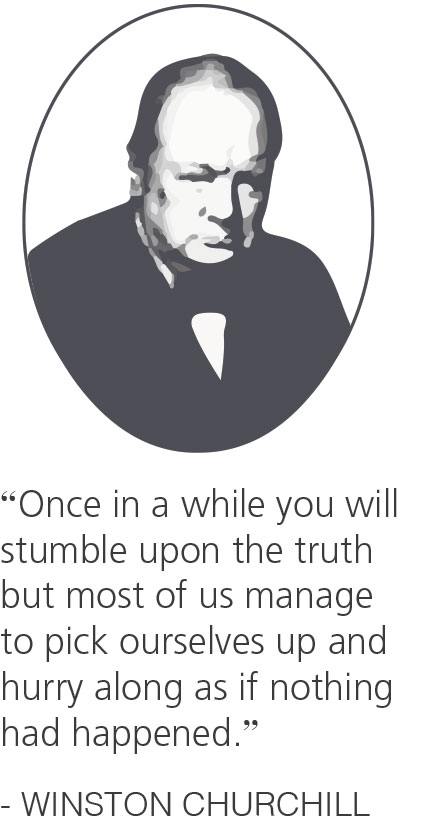By Chris Surdak
In this article, Chris Surdak speaks from experience and argues that financial models are not used to present scientific or mathematical fact but rather to further the political agenda of a business. But as Big Data takes hold, he asks what will be the future of financial models and the analysts who create them?
Join me for a moment and stand in awe of the mighty, omniscient and all-powerful financial model, determinant of the expenditure of perhaps tens of trillions of euros over the last forty years. Whether constructed in Lotus 1-2-3, crafted in Excel, or exquisitely finessed out of SAP, Oracle or another “Enterprise Resource Planning” package, the financial model is the maker of winners and losers; the judge and jury behind millions of business decisions every year; the creator and destroyer of dreams.
Nearly all business people are familiar with building, evaluating and working with these tools and the use of financial models in business decision-making is almost sacrosanct. This dedication to financial modeling has been based upon a shared belief that these models are the best representation of how businesses perform and what their future performance can and should be. Indeed, many business leaders hold the belief that the numbers generated from financial models are actual facts; things that can be taken as absolute truth and should not be questioned. Truly, woes betide any manager who acts in contravention of a pronunciation emanating from an Excel model, lest they find themselves in search of another job with another organisation!
[ms-protect-content id=”9932″]Financial modelling certainly has added value to many businesses and does appear to provide a degree of vigor to the process of making business decisions. However, I would argue that there is something amiss in our unquestioning faith in financial models. There is something foul in our Fourier transforms; something putrid in our pivot tables; something decrepit in our depreciation schedules. For all of our reliance upon financial modeling in business, the vast majority of the “facts” that we use in feeding these beasts are absolute rubbish. Our estimates are complete fabrications, our assumptions are myths, our calculations are artifacts of our innate need to categorise and comprehend things that may be neither categorical nor comprehensible.
All of this nonsense has been relatively tolerable over the decades. After all, in the absence of data and facts, estimates must certainly be better than nothing, correct? Perhaps so. As Winston Churchill one put it, “Once in a while you will stumble upon the truth but most of us manage to pick ourselves up and hurry along as if nothing had happened.” But in an era where actual facts about what is actually occurring in the world are readily available, estimates no longer look like reasonable approximations. Rather, they begin to look a great deal like negligence. In a connected, Big Data world financial modelers may be exposed to be the charlatans that they have always been and business people may have to begin addressing cold, hard facts as they make their decisions.
The Sorcerer’s Apprentice
I started my career as a spacecraft systems engineer for Lockheed Martin. In this role, I learned a variety of ways to mathematically model all kinds of physical phenomenon. Mass, acceleration, forces, moments, tensile strength, electrical resistance, et cetera; a wide variety of chemical, electrical and physical properties were constantly being evaluated in an attempt to design machines that would operate as intended. This sort of mathematical modeling of physical phenomena was critical to our work. When a component on a spacecraft required many months and hundreds of thousands of euros to produce, you weren’t likely to test many of them to destruction in order to come up with a workable design. I recently read about SpaceX, the commercial space company, whose latest attempt to recover a reusable launch vehicle ended with a crash landing. I laughed out loud when I heard their engineers refer to the crash as a “Rapid Unscheduled Disassembly.” Ah, those ever so clever rocket scientists.
 It should be no surprise that most of our modeling was performed using one of the most pervasive pieces of software ever created by modern society: the spreadsheet. Whether it was Lotus 1-2-3 or Microsoft Excel, millions of engineers and business people the world over have used the lowly spreadsheet to support untold numbers of decisions. Indeed, individuals, companies and entire industries have been built on nothing more than analysing numbers in spreadsheets. The X-Y array of mathematical cells is a miracle of modern technology.
It should be no surprise that most of our modeling was performed using one of the most pervasive pieces of software ever created by modern society: the spreadsheet. Whether it was Lotus 1-2-3 or Microsoft Excel, millions of engineers and business people the world over have used the lowly spreadsheet to support untold numbers of decisions. Indeed, individuals, companies and entire industries have been built on nothing more than analysing numbers in spreadsheets. The X-Y array of mathematical cells is a miracle of modern technology.
After a few years of this work, I left aerospace to pursue a business career. Upon completing my MBA at a prestigious university I found work applying my mathematical skills to the task of financial modeling. Shortly thereafter, I was creating fantastically complex Excel models that attempted to recreate entire corporations and industries on the hard drive of a simple laptop.
Many of the models used in business were (and still are) so pervasive, they have their own names. Return On Investment (ROI) is perhaps the most prevalent. Earned Value Added (EVA) has been another regional favorite. The list goes on and on. Soon, I was creating Excel models that literally stretched the capabilities of both the hardware and software I was using, and I found that I could create models that could say anything I wanted, at any time, given any set of provided inputs.
The Analytic Elephant in the Room
As I became ever more skilled at consuming and manipulating financial and business data I began to develop some unease over the work I was performing. It certainly felt like I was working with facts, just like in my spacecraft days, only some “facts” seemed to be a bit more flexible than others. As I developed models for my clients, managers or colleagues I began to notice a strange behavior as results started to flow out of the spreadsheets.
When my rocket-scientist colleagues received an unexpected output from a model they generally viewed the news with quizzical interest. Usually, this meant that we did something wrong, made an incorrect calculation or used the wrong units of measure in our calculations (an error made by other engineers which infamously led to the destruction of the Mars Climate Orbiter, valued at over $650 million in 1998 dollars). Engineers generally like finding an unexpected outcome from modeling because it tends to expose a failure in the model. It showed that there was an error in our mathematics; that our facts were somehow wrong.
This was not the experience I had with financial modeling. Here, when an unexpected, or more often, undesired outcome was generated by the model, the people displeased with these results changed the inputs to the model. They tweaked the supposed facts, so that the model would generate the output that was apparently acceptable to the intended audience. Suddenly I was no longer working with the third law of thermodynamics, or the conductivity of copper under standard temperature and pressure conditions. Rather, I was working with “Thomas’ best guess as to the internal rate of return,” or “Nancy’s estimate of project duration, based upon her annual performance goals”.
I realised rather quickly that while financial modeling appeared to be based upon facts, science and mathematics, in reality it was based upon politics, bureaucracy and brinksmanship. These analyses certainly looked like those I performed as an engineer, but the entire process was fundamentally flawed by the lack of actual science. After several years of performing this work, and after creating literally hundreds of financial models as a technology and business consultant, it became clear to me that most financial analysis work wasn’t science, it was sociology. It wasn’t processing, it was propaganda. It wasn’t humanity harnessing nature, it was humanity manipulating each other in the name of closing business, meeting a metric, or winning budget approval. Indeed, as I went deeper into the world of financial modeling I found that my analytic skills were taking a back seat to my political wits. Financial modeling wasn’t science; it was theater; that was the elephant in the room.
“There’s No Such Thing As Rounding”
Despite coming to this rather dire conclusion, I continued to valiantly try to apply analytics to all manner of business projects. Through the 2000’s and into the second decade of this century, the models that I and my employers used grew ever more sophisticated, detailed, even elegant. Indeed, today entire armies of “professionals” have made careers out of doing little else. Business investments worth hundreds of millions of dollars rest solely on the outputs of these models, yet the decision-makers relying upon these models have no idea that these same outputs have been “tuned” to tell a certain story. Inevitably, multiple layers of management, either internal or within a vendor’s organisation, had manipulated, twisted, re-worked or massaged the “facts” in the models to tell whatever story they wanted to have told.
I saw this over and over again throughout my career and each time I witnessed this standard way of doing things the engineer in me died just a little. On one such occasion I was working for a manager who was particularly adept at manipulating models to tell his preferred story, which he would then portray as “fact.” Late into one evening’s modeling session (or morning’s, if you like) I grew so frustrated by the obvious fallacy of the model I was being told to create, and the complete fabrication of the resulting numbers, I had a bit of a breakdown.
The entire exercise was so falsely precise that I could no longer stand it. Calculating the five-year ROI for the client down to the penny made me ill and in a fit of rebellion, I instructed the output cell in Excel to round the results of the calculation to the nearest thousand dollars. Pretending to be accurate to within a thousand dollars I could tolerate; pretending to be accurate to the penny was to me, simple blasphemy.
Later that morning my manager, upon reviewing the latest iteration of the model, called me in a fit of rage. What, he asked, had happened to the model? I had told him that I rounded the output of the resulting calculation to the nearest thousand dollars, which in itself was a baldly false claim. Frustrated, he replied to me, “Son, there’s no such thing as rounding. Fix the model, down to the penny.” And so it goes in the political world of financial modeling.
The Illusion of Control
If there is anything that I have learned after twenty years of modeling, and after creating literally thousands of models, it is that all of this effort is palliative. The predominant goal of all of this modeling is to give business people the illusion of understanding and control. It is to make us believe that we can forecast, understand and then manage the future. While these are all reasonable beliefs when one works with scientific facts, facts are not the grist for the mill of financial modeling. Time and again I have seen that the inputs, rules and logic of the financial models used in business are based upon politics, ambition and fear, and the outputs are tailored to tell a specific tale; to create a desired output.
Most of the effort behind models such as ROIs or EVAs goes to making us believe we have both understanding and control, when the reality is we have very little of either. But, we all know this game and have collectively played it for so long we assume that we must have one or more of these analyses in order to make (or rather to defend) any business decision that we make. We all buy into this illusion, and as a result, we are stuck continuing to play this game with one another, lest we are called out on our own guilt.
The End of the Modeling Road?
What if we were able to stop all of this nonsense? What if we could stop building and relying upon fake analyses of made-up numbers and go back to using facts as the basis of decision making? Is this even possible? I believe that it finally may be. And this belief is rooted in the business craze du jour we all call Big Data.
A New Era of Fact-Based Decision Making
There are legions of educated, dedicate professionals who have spent their entire careers working on financial models. They have created, edited, reviewed, analysed and anguished over these meaningless documents for years. These models have been central to their existence. Strangely, over the last half-century organisations have developed the notion that these activities somehow add value. For some reason making up numbers, pretending that they are facts and using these illusions to justify one’s decisions (or lack thereof) has earned the title of “work.”
With the proper application of Big Data, organisations should begin to find that estimation is no longer an option. Facts tend to work best in large groups and it’s extremely difficult to argue against a quintillion rows of data that demonstrate that your preferred answer is wrong. I have frequently said that Big Data isn’t a technology trend; it is a social one. I speak often of the disruption that Big Data will cause in business, without always clarifying what this disruption might entail. As discussed here, a great deal of the changes to come will be organisational, operational and behavioral, rather than technical. If you are not experiencing significant discomfort as you implement Big Data solutions, you’re likely not working hard enough.
My forecast is not that financial modeling will go away as Big Data takes hold. Rather, manipulative modeling will begin to yield to actual science. No manager will be able to fast-talk their way around a petabyte of data that bodes poorly for their position. Politics won’t be eliminated; we are human after all. But, it will become increasingly difficult for people to hide their agendas in made-up numbers, assumptions and estimates. More and more, these infestations will be replaced by facts based upon massive sets of real data. Our businesses should be all the better for it. And managers who have made a career out of manipulating data to achieve some political end may instead find that their careers suffer a “rapid, unscheduled disassembly” of their own.
About the Author
 Christopher Surdak is an Engineer, Juris Doctor, Strategist, Tech Evangelist, and Author of Data Crush: How the Information Tidal Wave is Driving New Business Opportunities, get Abstract’s International Book of the Year for 2014.
Christopher Surdak is an Engineer, Juris Doctor, Strategist, Tech Evangelist, and Author of Data Crush: How the Information Tidal Wave is Driving New Business Opportunities, get Abstract’s International Book of the Year for 2014.
[/ms-protect-content]








